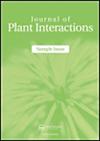Endophytic bacterial taxonomic and functional diversity in the seeds of wheat genotypes from different agroecologies
IF 3.3
3区 生物学
Q2 PLANT SCIENCES
引用次数: 0
Abstract
ABSTRACT Plant genotype and agroecology influence the composition and functionality of seed endophytic bacterial communities. Taxonomic analysis of 123 wheat seeds endophytic bacteria classified these into 23 genera predominantly under Firmicutes followed by Actinobacteria and Proteobacteria. Genus Bacillus was most abundant (30.7%) followed by Streptomyces (18.4%) with other representative genera such as Stenotrophomonas, Paenibacillus, Mixta, Enterobacter, Micrococcus, Pantoea, Alkalihalobacillus, Cortiobacterium, and more. Across agroecologies, the core microbiota of seeds consists of Bacillus, Streptomyces, Paenibacillus, and Stenotrophomonas, with maximum diversity and abundance observed in seeds of the North Western Plain Zone of India. Seed endophytic bacteria had PGP traits; nitrogen fixation (n = 101), production of IAA (n = 65), siderophores (n = 43), ammonia (n = 82) and solubilization of phosphate (n = 47), potassium (n = 37), and zinc (n = 8). The isolates produced HCN and hydrolytic enzymes and displayed antagonism against fungal pathogens. Overall, the information generated on wheat seeds’ endophytic bacterial taxonomy and beneficial traits may pave the path for the development of novel bioinoculants. Key message Wheat seeds from various agro-ecologies of India harbor diverse endophytic bacteria. Firmicutes were dominant followed by Actinobacteria and Proteobacteria. Genus Bacillus, Stenotrophomonas, Streptomyces, and Paenibacillus were core endophytic bacteria in different agro-ecologies. The endophytic bacterial strains were displaying diverse functional traits.不同农业生态小麦基因型种子内生细菌的分类和功能多样性
本文章由计算机程序翻译,如有差异,请以英文原文为准。
求助全文
约1分钟内获得全文
求助全文
来源期刊

Journal of Plant Interactions
PLANT SCIENCES-
CiteScore
5.30
自引率
6.20%
发文量
69
审稿时长
>12 weeks
期刊介绍:
Journal of Plant Interactions aims to represent a common platform for those scientists interested in publishing and reading research articles in the field of plant interactions and will cover most plant interactions with the surrounding environment.
 求助内容:
求助内容: 应助结果提醒方式:
应助结果提醒方式:


